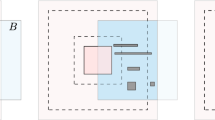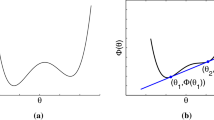Abstract
We consider a class of nonconvex energy functionals that lies in the framework of the peridynamics model of continuum mechanics. The energy densities are functions of a nonlocal strain that describes deformation based on pairwise interaction of material points and as such are nonconvex with respect to nonlocal deformation. We apply variational analysis to investigate the consistency of the effective behavior of these nonlocal nonconvex functionals with established classical and peridynamic models in two different regimes. In the regime of small displacement, we show the model can be effectively described by its linearization. To be precise, we rigorously derive what is commonly called the linearized bond-based peridynamic functional as a \(\Gamma \)-limit of nonlinear functionals. In the regime of vanishing nonlocality, the effective behavior of the nonlocal nonconvex functionals is characterized by an integral representation, which is obtained via \(\Gamma \)-convergence with respect to the strong \(L^p\) topology. We also prove various properties of the density of the localized quasiconvex functional such as frame-indifference and coercivity. We demonstrate that the density vanishes on matrices whose singular values are less than or equal to one. These results confirm that the localization, in the context of \(\Gamma \)-convergence, of peridynamic-type energy functionals exhibits behavior quite different from classical hyperelastic energy functionals.
Similar content being viewed by others
Notes
By a dense subcollection \({\mathfrak {D}}(\Omega )\) of \(\mathcal {A}_0(\Omega )\) we mean for any \(A, B\in \mathcal {A}_0(\Omega )\), such that \(A\Subset B\) there exists \(D_0\in {\mathfrak {D}}(\Omega )\) so that \(A\Subset D\Subset B\).
References
Aguiar, A.R., Royer-Carfagni, G.F., Seitenfuss, A.B.: Wiggly strain localizations in peridynamic bars with non-convex potential. Int. J. Solids Struct. 138, 1–12 (2018)
Alali, B., Gunzburger, M.: Peridynamics and material interfaces. J. Elast. 120(2), 225–248 (2015)
Alicandro, R., Ansini, N., Braides, B., Piatnitski, A., Tribuzio, A.: A Variational Theory of Convolution-Type Functionals. Springer (2020). https://doi.org/10.1007/978-981-99-0685-7
Alicandro, R., Cicalese, M.: A general integral representation result for continuum limits of discrete energies with superlinear growth. SIAM J. Math. Anal. 36(1), 1–37 (2004)
Bellido, J.C., Mora-Corral, C., Pedregal, P.: Hyperelasticity as a \(\Gamma \)-limit of peridynamics when the horizon goes to zero. Calc. Var. PDEs 54, 1643–1670 (2015)
Bellido, J.C., Cueto, J., Mora-Corral, C.: Bond-based peridynamics does not converge to hyperelasticity as the horizon goes to zero. J. Elast. 141(2), 273–289 (2020)
Bourgain, J., Brezis, H., Mironescu, P.: Another look at Sobolev spaces. In: José Luis, M., Edmundo R., Agnes S. (eds.), Optimal Control and Partial Differential Equations: In Honour of Professor Alain Bensoussan’s 60th Birthday, pp. 439–455. IOS Press (2001)
Braides, A., Defranceschi, A.: Homogenization of Multiple Integrals, vol. 12. Oxford University Press (1998)
Braides, A., Maso, G.D.: Compactness for a class of integral functionals with interacting local and non-local terms. Calc. Var. 62, 148 (2023). https://doi.org/10.1007/s00526-023-02491-w
Dacorogna, B.: Introduction to the Calculus of Variations. Imperial College Press (2014)
Dal Maso, G.: An introduction to \(\Gamma \)-convergence. In: Progress in Nonlinear Differential Equations and their Applications. Birkhauser Boston Inc, Boston (1993)
Dal Maso, G., Negri, M., Percivale, D.: Linearized elasticity as \(\Gamma \)-limit of finite elasticity. Set Valued Anal. 10, 165–183 (2002)
Dayal, D., Bhattacharya, K.: Kinetics of phase transformations in the peridynamic formulation of continuum mechanics. J. Mech. Phys. Solids 54(9), 1811–1842 (2006)
Du, Q., Mengesha, T., Tian, X.: Nonlocal criteria for compactness in the space of Lp vector fields. Preprint at arXiv:1801.08000
Du, Q., Tao, Y., Tian, X.: A peridynamic model of fracture mechanics with bond-breaking. J. Elast. 132, 197–218 (2018). https://doi.org/10.1007/s10659-017-9661-2
Evans, L.C.: Partial Differential Equations. American Mathematical Society, Providence (2010)
Fonseca, I., Leoni, G.: Modern Methods in the Calculus of Variations: \(L^p\) Spaces. Springer (2007)
Le Dret, H., Raoult, A.: The nonlinear membrane model as variational limit of nonlinear three-dimensional elasticity. J. Math. Pures Appl. 74(6), 549–578 (1995)
Lipton, R.: Dynamic brittle fracture as a small horizon limit of peridynamics. J. Elast. 117(1), 21–50 (2014)
Lipton, R.: Cohesive dynamics and brittle fracture. J. Elast. 124, 143–191 (2016)
Mengesha, T., Du, Q.: The peridynamic system as a nonlocal boundary value problem. J. Elast. 116, 27–51 (2014)
Mengesha, T., Du, Q.: On the variational limit of a class of nonlocal functionals related to peridynamics. Nonlinearity 28(11), 3999 (2015)
Ponce, A.C.: An estimate in the spirit of Poincare’s inequality. J. Eur. Math. Soc. 6(1), 1–15 (2004)
Ponce, A.C.: A new approach to Sobolev spaces and connections to \(\gamma \)-convergence. Calc. Var. Partial Differ. Equ. 19(3), 229–255 (2004)
Reshetnyak, Y.G.: Liouville’s conformal mapping theorem under minimal regularity hypotheses. Sibirsk. Mat. Ž. 8, 835–840 (1967)
Silling, S.A., Lehoucq, R.B.: Convergence of peridynamics to classical elasticity theory. J. Elast. 93, 13–37 (2008)
Silling, S.A., Weckner, O., Askari, E., et al.: Crack nucleation in a peridynamic solid. Int. J. Fract. 162, 219–227 (2010). https://doi.org/10.1007/s10704-010-9447-z
Silling, S.A.: Reformulation of elasticity theory for discontinuities and long-range forces. J. Mech. Phys. Solids 48, 175–209 (2000)
Silling, S.A.: Linearized theory of peridynamic states. J. Elast. 99, 85–111 (2010)
Silling, S.A., Epton, M., Weckner, O., Xu, J., Askari, E.: Peridynamic states and constitutive modeling. J. Elast. 88, 151–184 (2007)
Acknowledgements
This manuscript has benefited from discussions with Qiang Du, Marta Lewicka, Armin Schikorra, and Xiaochuan Tian. The authors thank them for their valuable insight and input.
Author information
Authors and Affiliations
Corresponding author
Additional information
Publisher's Note
Springer Nature remains neutral with regard to jurisdictional claims in published maps and institutional affiliations.
Appendix A: Characterizations of distance-preserving maps
Appendix A: Characterizations of distance-preserving maps
Theorem A.1
Let \(\Omega \subset \mathbb {R}^d\) be a bounded domain. Suppose \( \textbf{v}: \Omega \rightarrow \mathbb {R}^d\) is measurable, and suppose \(\textbf{v}\) satisfies
for \(\mathcal {L}^{2d}\)-almost every \((\textbf{x},\textbf{y}) \in \Omega \times \Omega \), where in general \(\mathcal {L}^N\) denotes N-dimensional Lebesgue measure. Then, there exists a constant matrix \(\mathbb {F}\in \mathcal {O}(d)\) and \(\textbf{b}\in \mathbb {R}^d\) such that \(\textbf{v}(\textbf{x}) = \mathbb {F}\textbf{x}+ \textbf{b}\) for almost every \(\textbf{x}\in \Omega \).
Proof
We prove the result first under the additional assumption that \(\textbf{v}: \Omega \rightarrow \mathbb {R}^d\) is continuous. Then, the functions \(f_1(\textbf{x},\textbf{y}):= |\textbf{v}(\textbf{x})-\textbf{v}(\textbf{y})|\) and \(f_2(\textbf{x},\textbf{y}):=|\textbf{x}-\textbf{y}|\) are continuous on \(\Omega \times \Omega \). Let \(X \subset \Omega \times \Omega \) be the set where (A.1) holds. Then, \((\Omega \times \Omega ) \backslash X\) is dense in \(\Omega \times \Omega \). So by density and continuity we have
Since the relation (A.1) is translation- and shift-invariant, we can assume without loss of generality that \(B({\textbf {0}},R) \subset \Omega \) for some \(R>0\) and \(\textbf{v}({\textbf {0}}) = {\textbf {0}}\). We will show that \(\textbf{v}(\textbf{x}) = \mathbb {F}\textbf{x}\) for some constant matrix \(\mathbb {F}\in \mathcal {O}(d)\), obtaining the result for continuous functions.
First, by (A.1) \(|\textbf{v}(\textbf{x})|^2 = |\textbf{v}(\textbf{x})-\textbf{v}({\textbf {0}})|^2 = |\textbf{x}-{\textbf {0}}|^2 = |\textbf{x}|^2\). The identity
for every \((\textbf{x},\textbf{y}) \in \Omega \times \Omega \) follows, since
Define the \(d \times d\) matrix
where \(\textbf{e}_k\) is the vector in \(\mathbb {R}^d\) with kth coordinate 1 and all other coordinates 0. Using this definition and using (A.2) with \(R \textbf{e}_j\) in place of \(\textbf{y}\),
This is true for any \(j \in \{ 1, \ldots , d\}\), and so
Again using the definition of \(\mathbb {F}\) and using (A.2) with \((R \textbf{e}_j, R \textbf{e}_k)\) in place of \((\textbf{x},\textbf{y})\),
Therefore, \(\mathbb {F}^T \mathbb {F}= \mathbb {I}\), and we conclude that \(\textbf{v}(\textbf{x}) = \mathbb {F}\textbf{x}\) with \(\mathbb {F}\in \mathcal {O}(d)\).
Now suppose \(\textbf{v}\) is measurable. By Lusin’s theorem for every \(n \in \mathbb {N}\) there exists a closed set \(K_n \subset \Omega \) with \(\mathcal {L}^d(\Omega \setminus K_n) < \frac{1}{n}\) such that \(\textbf{v}\) is continuous on \(K_n\). By (A.1) \(\textbf{v}\) is also Lipschitz on \(K_n\), with Lipschitz constant 1. By Kirszbraun’s theorem there exists a function \(\textbf{v}_n: \mathbb {R}^d \rightarrow \mathbb {R}^d\) that is 1-Lipschitz and coincides with \(\textbf{v}\) on \(K_n\). Therefore, by Rellich’s theorem there exists a subsequence (not relabeled) \(\{\textbf{v}_n\}\) that converges uniformly on \({\overline{\Omega }}\) to a continuous and 1-Lipschitz function \(\widetilde{\textbf{v}}\). By definition of the \(\textbf{v}_n\) it follows that \(\textbf{v}= \widetilde{\textbf{v}}\) almost everywhere on \(\Omega \). Therefore, \(\textbf{v}\) has a Lipschitz (hence continuous) representative, and the first part of the proof applies. \(\square \)
This rigidity result can be strengthened in the spirit of [25], as we demonstrate in the next theorem.
Theorem A.2
Let \(m \ge 1\), let \(\rho \in L^1(\mathbb {R}^d)\) be a nonnegative radial kernel satisfying \(B({\varvec{0}},r) \subset {{\,\textrm{supp}\,}}\rho \subset B({\varvec{0}},R)\) for given \(0< r < R\), and let \(\Phi \) be a nondecreasing convex function satisfying (2.3). Suppose a sequence of vector fields \(\{ \textbf{v}_n \}_n \subset \mathfrak {W}^{\rho ,p}(\Omega ;\mathbb {R}^d)\) satisfies
Suppose additionally that there exists a function \(\textbf{v}\in L^{1}(\Omega ;\mathbb {R}^d)\) such that \(\textbf{v}_n \rightarrow \textbf{v}\) in \(L^{1}(\Omega ;\mathbb {R}^d)\). Then, there exists a constant matrix \(\mathbb {F}\in \mathcal {O}(d)\) and a vector \(\textbf{b}\in \mathbb {R}^d\) such that \(\textbf{v}(\textbf{x}) = \mathbb {F}\textbf{x}+ \textbf{b}\) for almost every \(\textbf{x}\in \Omega \).
Proof
Since \(\textbf{v}_n \rightarrow \textbf{v}\) in \(L^{1}(\Omega ;\mathbb {R}^d)\) there exists a subsequence (not relabeled) \(\{\textbf{v}_n\}_n\) that converges to \(\textbf{v}\) \(\mathcal {L}^d\)-almost everywhere in \(\Omega \). Since \(\Phi \) is continuous,
and so by Fatou’s lemma
Therefore, it must be that \( \rho (\textbf{y}-\textbf{x})\Phi \left( |s_m[\textbf{v}](\textbf{y},\textbf{x})| \right) = 0 \text { for a.e. } \textbf{y}\in {{\,\textrm{supp}\,}}\rho + \textbf{x}\,, \textbf{x}\in \Omega \,. \) For any \(\textbf{x}\in \Omega \), define \(r_{\textbf{x}} = \min \{r,{{\,\textrm{dist}\,}}(\textbf{x},\partial \Omega )\}\). Then by assumption on \(\rho \),
Now fix \(\textbf{x}_0 \in \Omega \) and fix \(r_0 = r_{\textbf{x}_0}\). Then, by definition of \(\Phi \) and \(s_m\)
The relation then holds for \(\mathcal {L}^{2d}\)-a.e. \((\textbf{x},\textbf{y}) \in B(\textbf{x}_0,r_0/2) \times B(\textbf{x}_0,r_0/2)\), and so Lemma A.1 applies on \(B(\textbf{x}_0,r_0/2)\).
By covering \(\Omega \) with sets of the form \(B(\textbf{x}_0,r_0/2)\), we see that \(\textbf{v}\) is a possibly piecewise affine map on \(\Omega \). To conclude, note that since \(\Omega \) is a domain there exists a finite chain of sets of the form \(B(\textbf{x}_0,r_0/2)\) between any \(\textbf{x}_1\) and \(\textbf{x}_2\) in \(\Omega \), and thus \(\textbf{v}\) must be the same affine map at both points. \(\square \)
Theorem A.3
Suppose that \(\textbf{v}\in C^2({\overline{\Omega }};\mathbb {R}^d)\) satisfies (1.8). Then there exists a constant matrix \(\mathbb {F}\in \mathcal {O}(d)\) and a vector \(\textbf{b}\in \mathbb {R}^d\) such that \(\textbf{v}(\textbf{x}) = \mathbb {F}\textbf{x}+ \textbf{b}\) for every \(\textbf{x}\in \Omega \).
Proof
First, since \(\textbf{v}\in C^2{\overline{\Omega }};\mathbb {R}^d)\), \(\det \nabla \textbf{v}\in C^1({\overline{\Omega }};\mathbb {R}^d)\), with
But \(|\nabla \textbf{v}(\textbf{x})|^2 = \textrm{tr}( \nabla \textbf{v}^T \nabla \textbf{v}) = d\), so therefore \(\det \nabla \textbf{v}\) is constant in all of \({\overline{\Omega }}\). Thus, either \(\nabla \textbf{v}= \textrm{cof} \nabla \textbf{v}\) for all \(\textbf{x}\in \Omega \) or \(\nabla \textbf{v}= -\textrm{cof} \nabla \textbf{v}\) for all \(\textbf{x}\in \Omega \). In both cases it follows from the Piola identity \(\textrm{div}\,\textrm{cof} \nabla \textbf{v}= {\textbf {0}}\) that \(\textbf{v}\) is a harmonic function on \(\Omega \). Thus \(\textbf{v}\in C^{\infty }(\Omega )\), and so we can compute
Thus, \(\nabla \textbf{v}(\textbf{x})\) is constant in \(\Omega \), and necessarily belongs to \(\mathcal {O}(d)\). \(\square \)
Rights and permissions
Springer Nature or its licensor (e.g. a society or other partner) holds exclusive rights to this article under a publishing agreement with the author(s) or other rightsholder(s); author self-archiving of the accepted manuscript version of this article is solely governed by the terms of such publishing agreement and applicable law.
About this article
Cite this article
Mengesha, T., Scott, J.M. Linearization and localization of nonconvex functionals motivated by nonlinear peridynamic models. Continuum Mech. Thermodyn. (2024). https://doi.org/10.1007/s00161-024-01299-z
Received:
Accepted:
Published:
DOI: https://doi.org/10.1007/s00161-024-01299-z




